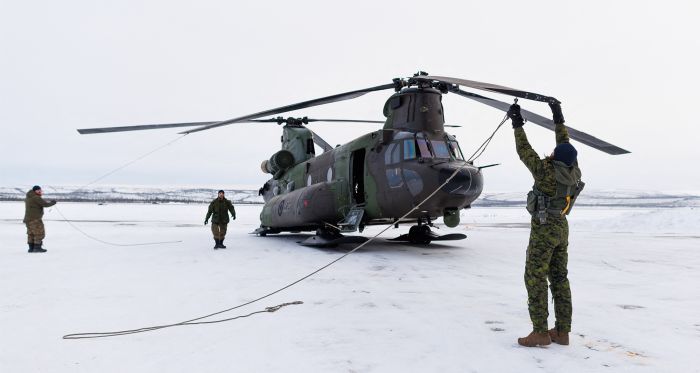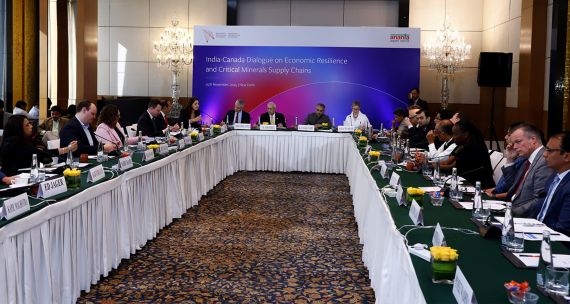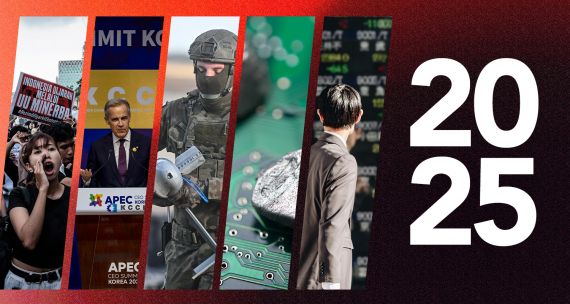With geopolitical tensions and friction with the United States rising under the Trump 2.0 administration, Canada is recognizing the need for greater self-reliance in producing military equipment and seeking to diversify its defence partnerships. A key focus is the Arctic – a region where Russia, the largest Arctic state, continues to expand its military and commercial footprint. While China does not border the Arctic, it has declared itself a “near-Arctic state” and is steadily increasing its strategic activities in the region. The Arctic’s importance has only grown as melting ice unlocks access to oil, gas, and vital shipping routes. In response, Canadian Prime Minister Mark Carney recently announced plans to bolster Canada’s military presence in the North, underscoring the region’s growing significance in national defence planning.
In this context, trilateral co-operation between Canada, South Korea, and Japan presents a timely opportunity. The industrial strengths of Canada’s Northern Pacific partners – in defence, shipbuilding, and robotics – align with Canada’s investment priorities in surveillance systems, autonomous military platforms, maritime defence, and Arctic-capable equipment. Conversely, the high-tech sectors of Seoul and Tokyo – still heavily reliant on Chinese-sourced critical minerals – would benefit from upstream integration with Canada’s resource base. With its vast reserves, Canada can offer stable inputs for key components like sensors, batteries, and alloys, strengthening the supply chain resilience of South Korean and Japanese defence products that, in turn, support Canada’s Arctic security.
From Ottawa’s perspective, greater trilateral co-operation would also align with its 2022 Indo-Pacific Strategy, which identifies Japan and South Korea as key partners for deeper strategic and economic engagement in the region. More importantly, experts have found that, unlike China, which seeks to lay the groundwork for future claims to Arctic stakeholder status, South Korea and Japan have focused more on engaging through existing Arctic governance structures. In January 2020, South Korea launched the ‘Arctic Club in Korea’ to bring together ambassadors from Arctic states, including Canada, to promote co-operation on conservation. Similarly, Japan’s Arctic Policy includes its leadership in shaping global environmental agreements such as the Kyoto Protocol and Aichi Biodiversity Targets and emphasizes contributing to sustainable Arctic development.
Canada’s Arctic needs South Korean ships and Japanese satellites
Recent Russian and Chinese military activity in the Arctic makes the defence of Canada’s northern sovereignty non-negotiable. The U.S. was previously regarded as a dependable partner in supporting Canada’s northern defence; however, the return of the Trump administration in 2025 – marked by remarks about acquiring Greenland, claims to annex Canada as the “51st state,” and the imposition of “America First” tariffs – has quickly and significantly undermined that trust. In light of these developments, the Expert Group on Canada-U.S. Relations has called for Canada to diversify its security partnerships and, critically, to take fuller responsibility for providing its own security.
Canada’s Our North, Strong and Free (ONSAF) strategy, released in April 2024, lays out a blueprint for Arctic sovereignty, North American Aerospace Defense Command (NORAD) modernization, and greater defence self-sufficiency. Committing C$73 billion over two decades, the plan targets increasing defence spending to 1.76 per cent of GDP by 2030. A core component of ONSAF is the expansion of Canada’s Arctic-ready defence, including the acquisition of up to 12 conventionally-powered submarines with under-ice capabilities; a C$9.4-billion investment in munitions supply; C$2.6 billion for long-range artillery systems to replace aging systems and match peer-level firepower; and a C$18.4-billion investment for new tactical helicopters suited to the North’s extreme conditions.
South Korea is uniquely positioned to support Canada’s Arctic defence procurement. Unlike many Western firms, South Korea’s defence industry benefits from continuous production cycles sustained by tensions with North Korea, enabling rapid manufacturing and delivery. As a long-standing U.S. ally since 1953 and with decades of biannual joint military exercises, South Korea also develops systems compatible with NATO and U.S. standards – exemplified by Hanwha’s K9 self-propelled howitzer. Indeed, Hanwha has expressed active interest in offering the K9 deal to Canada. In July this year, a delegation of presidential envoys, led by former four-star general and current lawmaker Kim Byeong-joo, visited Canada to advocate for South Korea’s deeper involvement in Canada’s defence modernization – especially future submarine and artillery programs.
In aviation, South Korea’s cost-effective tactical helicopters offer a timely solution to the need to modernize Canada’s aging fleet and enhance Arctic rapid response. Additionally, South Korea’s submarine manufacturing – led by Hanwha Ocean and HD Hyundai Heavy Industries, bidding jointly for Canada’s US$20-billion submarine program – directly aligns with Canada’s under-ice naval expansion.
Japan, too, brings vital expertise in military production. Its leadership in advanced shipbuilding, particularly with diesel-electric submarines like the Sōryū and Taigei classes, complements Canada’s current needs. Japan’s strengths in robotics and unmanned systems – key to Canada’s ‘digital transformation’ goals under ONSAF – can reduce operational burdens through AI-enhanced platforms like Unmanned Underwater Vessels and Unmanned Surface Vessels.
On communications and situational awareness, Japan’s advanced satellite and radar systems could enhance Canada’s northern sensor networks. While Canada has partnered with Australia on over-the-horizon radar systems, Japanese technologies can add valuable redundancy in unpredictable environments.
Japan and South Korea’s defence industries need Canada’s critical minerals
In exchange for defence technology, Canada offers Japan and South Korea a stable, democratic source of critical minerals – essential for defence applications such as precision-guided munitions and advanced batteries. The risks of over dependence on Chinese supply chains were starkly illustrated by South Korea’s 2021 urea crisis, which was triggered by a sudden halt in Chinese exports and fuelled concerns that similar disruptions could cripple future defence production.
Rare earth elements (REE), indispensable for precision-guided munitions and radar technologies, are a particular vulnerability – South Korea and Japan import more than 47 per cent and 60 per cent of their REEs from China, respectively. Canada’s Saskatchewan Rare Earth Processing Facility and Rio Tinto’s scandium oxide plant in Quebec position Canada as a strategic supplier. Joint investments in REE processing and recycling could further integrate Canada’s raw materials with Japan and South Korea’s advanced manufacturing capabilities.
Cobalt, vital for lithium-ion batteries in military assets and alloys for munitions, poses similar risks and opportunities. With Chinese firms controlling 80 per cent of cobalt production in Congo-Kinshasa – from where over half of the world’s cobalt is sourced – supply vulnerabilities remain acute. As the world’s fourth-largest cobalt producer, Canada offers a stable and sustainable alternative. Projects like NICO by Fortune Minerals in the Northwest Territories and Electra Battery Materials in Ontario can support a trilateral supply chain linking Canadian resources with the Japanese and South Korean defence industries.
Existing bilateral Memorandums of Understanding signed between Canada and South Korea and Memorandums of Co-operation signed between Canada and Japan, initially focused on electric vehicle and battery supply chains, could be extended to defence production.
Overcoming challenges for trilateral co-operation on the Arctic
Canada, Japan, and South Korea share a common concern: their economic ties with China and their security partnerships with the U.S. are increasingly uncertain. Whether through economic coercion by Beijing or transactional diplomacy from Washington, the vulnerabilities from these structural dependencies have become acute. Diversification and strategic autonomy are now imperative. This makes the ‘Canada- Japan-Korea trilateral’ an especially viable issue-focused partnership.
By securing the upstream inputs needed for defence technologies (critical minerals) and enhancing the downstream applications (defence platforms and systems), the three countries could build a resilient ecosystem. Integrating these pillars strengthens the entire value chain from raw material to deployed capability, maximizing strategic autonomy and minimizing external exposure in today's unstable geopolitical environment.
A top priority should be the establishment of a Trilateral Working Group of senior officials, industry leaders, and strategic advisors. This working group would harmonize investment rules, identify priority areas, and pilot joint projects, creating a structured channel for continuous dialogue and conflict resolution.
A critical factor will be the involvement of Indigenous Peoples, particularly in Canada’s Arctic regions – Nunavut and the Northwest Territories, where many critical mineral deposits lie on constitutionally protected Indigenous lands. Any co-operation that ignores Indigenous rights risks both legal challenges and reputational damage.
To address this, the trilateral framework must prioritize Indigenous inclusion as a foundational element, not an afterthought. Benefit-sharing agreements should be established to ensure Indigenous communities receive direct gains from resource development, through employment opportunities and infrastructure investment. Co-ownership models, such as equity partnerships, can provide Indigenous groups with meaningful decision-making power in critical mineral projects. Formalizing Indigenous diplomacy by including Indigenous representatives in trilateral discussions would recognize them as sovereign partners in Arctic governance.
Finally, geopolitical pressures from the U.S. must also be carefully managed. While this trilateral framework is intended to complement, not replace, existing alliances, there is a risk that Washington could perceive closer Canada–Northeast Asia co-operation as diluting NORAD commitments or undermining the U.S.-led security order. Likewise, as China has previously pursued its own trilateral discussions on the Arctic with Japan and South Korea, it could view a Canada-Japan- Korea trilateral initiative as competition and retaliate against Canadian, Japanese and South Korean industries.
To mitigate these risks with the U.S. and China, Canada- Japan-Korea trilateral cooperation should be explicitly framed as a pragmatic diversification strategy, not an alternative to existing alliances. Strategic communication is key: targeted diplomatic briefings, particularly with U.S. counterparts, could clarify intentions and reinforce commitments to current partnerships. Public messaging, including through the media, should emphasize the issue-specific nature of the collaboration. Business-to-business (Track 2) engagement could further underscore the practical, non-threatening aims of the partnership.
• Edited by Jeehye Kim, Senior Program Manager, Northeast Asia, APF Canada





